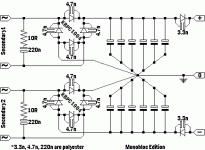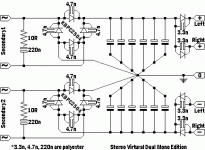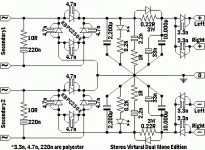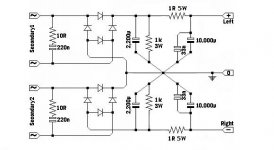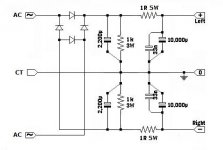Thanks!
Comparing the below amplifier examples (they're both single rail for simplicity). Text symbols of "<" and ">" indicate DC transient charge flow right after a powerful bass beat. Both examples have the power supply on the same board as the amp, but one of them isn't dull.
Example 1:
transformer > bridge rectifier > power supply reservoir < small 1cm trace < amp board caps
both the DC and noise returned while power supply reservoir awaits charge
amp board caps discharged/disturbed, an open door to noise
Example 2:
transformer > bridge rectifier > power supply reservoir > D//C series filter > amp board caps
only the noise returned while the power supply reservoir awaits charge
amp caps stay full, Shields UP!
Tomfoolery:
That was mild, but now I have plugged both examples into an old fashioned Christmas tree lights blinker!
Example1 plays dull and cuts out when connected to the blinker
Example2 didn't play dull and the blinker didn't make it cut out
(Both did work better without the blinker, so I've now removed it.)
Question:
On Example 2's D//C series filter, how big does the "C" (or an RC) need to be to provide a return path to send noise away from the amplifier? I had only 3.3n.
Well, that was interesting. So, what do you think of this?:Yes, provided that the frequency, amplitude and phase of these sine waves are such that they add up to some approximation to a low frequency square wave. I thought we established much earlier in the thread that an LF square wave is the hardest thing for a PSU to cope with, in terms of current delivery and hence required reservoir capacitor value. Anything else is easier. There may be a separate issue with things like IM caused by capacitor nonlinearity, but that is for another thread.
Comparing the below amplifier examples (they're both single rail for simplicity). Text symbols of "<" and ">" indicate DC transient charge flow right after a powerful bass beat. Both examples have the power supply on the same board as the amp, but one of them isn't dull.
Example 1:
transformer > bridge rectifier > power supply reservoir < small 1cm trace < amp board caps
both the DC and noise returned while power supply reservoir awaits charge
amp board caps discharged/disturbed, an open door to noise
Example 2:
transformer > bridge rectifier > power supply reservoir > D//C series filter > amp board caps
only the noise returned while the power supply reservoir awaits charge
amp caps stay full, Shields UP!
Tomfoolery:
That was mild, but now I have plugged both examples into an old fashioned Christmas tree lights blinker!
Example1 plays dull and cuts out when connected to the blinker
Example2 didn't play dull and the blinker didn't make it cut out
(Both did work better without the blinker, so I've now removed it.)
Question:
On Example 2's D//C series filter, how big does the "C" (or an RC) need to be to provide a return path to send noise away from the amplifier? I had only 3.3n.
Last edited:
Yes. Instead of noise return path question howabout this instead: How big of a cap or RC would damp a 6a05? I didn't use a 6a05 but those are fairly noisy, and if the bypass could take care of that much, then that's probably enough to get the job done.Sorry, Daniel, I have no idea what you are talking about. Where/what is this noise you are talking of? Do you mean noise in the same sense that the rest of us mean noise?
The latter. The Christmas tree lights blinker was a device sold a long time ago, and quite similar to the turn indicator blinker, it made the lights blink. This can be used to cause very bad quality power for a test.Daniel won't use normal technical nor simple english language. As a result most of his posts are lost to me. eg, blinker?
a eye guard for a horse, or a turn indicator on an automobile?
And then I compared two examples; both are the compact sort with the power supply on same board as the amplifier. One of the examples had its 1cm "umbilical" trace cut and D//C installed (in-between reservoir capacitance and amp caps). That one succeeded despite bad power.
Likewise, the example with the filter also succeeds with a smaller transformer than the example without the filter. The amp board caps don't instantly lose charge every time the power supply reservoir waits on the transformer.
Other way to see it: Which can deliver a charge into the power supply faster, the amp board caps or a bogged down transformer?
Well, I didn't want the amplifier's caps to lose charge needlessly.
I assume you mean a 6a05 rectifier? What has damping got to do with reservoir cap size?How big of a cap or RC would damp a 6a05?
What is a D//C?
Why do you want to deliver charge quickly 'into the power supply'? In most PSUs the charge flows one way: from the rectifier, via the reservoir, to the smoothers/decouplers. Charge does not usually flow back from the smoothers to the reservoir. Once again, I have no idea what you are talking about.Which can deliver a charge into the power supply faster, the amp board caps or a bogged down transformer?
transformer > bridge rectifier > power supply reservoir > D//C series filter > amp board capsI assume you mean a 6a05 rectifier? What has damping got to do with reservoir cap size? What is a D//C?
D//C is exactly as it says, 1 diode paralleled with 1 capacitor.
The amplifier works, therefore the diode is NOT installed backwards.
If that doesn't do it, the following explanation won't help either:
A large capacity fuel container of 120cm high. -and-
A small capacity fuel container of 220cm high.
I want to connect them but I don't want fuel to flow out of the small capacity container.
Do I use an ordinary pipe or do I use a one way valve?
Similar to (but not exactly the same as):
I want to connect a power board, but I DON'T want charge stolen out of the amplifier board.
Do I use an ordinary wire or do I use a diode?
P.S.
(no fuel was used except for analogy)
Last edited:
I want the DC never to leave the amp board. I want the AC to travel the reverse path (away from the amp power circuit) as quickly as possible. The resulting filter is D//C.Why do you want to deliver charge quickly 'into the power supply'? In most PSUs the charge flows one way: from the rectifier, via the reservoir, to the smoothers/decouplers. Charge does not usually flow back from the smoothers to the reservoir. Once again, I have no idea what you are talking about.
Umbilical Cable Substitute for compact amplifier+power combination boards.
Could you do me a favor and go look at the MyRef and see what's missing from the power circuit? The umbilical cable that would connect a power board to an amplifier board is missing. When the 10,000u caps need charge, it is most unfortunate that the umbilical cable is missing, because the 1cm trace is not an adequate substitute, since the features are much different. What substitutes may fit 1cm?
Due to the missing cable, after replaying bass (or anything significant) the charge leaves the 1000u caps (normal amps have more like 330u size there, but LM3886's shout needs the bigger caps). The very first thing that happens is amp decoupling cap discharge error, and that's as good as a flat tire. That amplifier is briefly defenseless for every transient. It is the same blunder as an air compressor with temporarily less pressure than the tire you're trying to inflate. This problem is typical of compact combination amp+power boards.
The error causes lower resolution audio (the dull effect that Nico described earlier). I suppose that amplifier would be extremely dull except for the LM3886's harmonic noise that is neither dull nor pleasant. The tuning is appropriate if one must use that part; however, that particular power circuit (omitted umbilical cable) is still causing lower resolution audio.
After that discharge mistake (due to the missing cable) the 1000u amp decoupling caps are in charging condition, temporarily opening the door to noise (a "defenseless" condition). Lastly, both the 10,000u and 1000u charge back up and the defense role of the 1000u is restored. . . until the next bass note. This seems so much like trousers that won't stay up.
We need "umbilical cable substitute"
Of course we could install an umbilical cable and we could give the MyRef an external power board. However, I have proposed D//C as a compact umbilical cable substitute that will fit nicely in the 1cm space provided.
Umbilical cable could slow down the unwanted reverse charge from the 1000u to the 10,000u as could a resistor or D//R. The D//R has an error of two paths forward at two different times, which may or may not be suitable. However, I'm working with D//C right now since it is OK if HF noise exits via return path the 1000u, but not okay if the DC exits the 1000u due to mistaken/compact layout.
Of the several possible umbilical cable substitutes, D//C was the most interesting because of the 1 thing it does differently--blocks some of the caveats of a too small transformer. A too small transformer makes "wrong way charge" even more likely to result in a defenseless amplifier; however, D//C blocked that path. Indeed, it was a surprisingly effective against my crude bad power test procedure. I gave it the power equivalent of poison, and it simply ignored that.
As seen with regulators, the amp decoupling caps weren't mistakenly discharged, since return path for DC didn't work. This is different than umbilical cable which merely hinders both right way and wrong way charge flow. This is not different than umbilical cable that's long enough to guarantee that transient charge for the 10,000u power supply reservoir will always come from the transformer but never from the 1000u amp decoupling caps; and that size umbilical cable is when the amplifier and power supply are in two different boxes. But, if you wanted one little compact all-in-one deal (like the MyRef), try D//C as a substitute for the umbilical cable.
Did I finally manage to explain it?
I wish I had Not picked an LM3886 example that employs power circuit noise to level its response. A compact, discrete amp+power board (or an STK with the bridge rectifier and power supply reservoir aboard with the amplifier) would have given a better example. . . of employing "umbilical cable substitute"
P.S.
If I could only manage to explain this, it is half of answering Nico's question--No need for avoiding large capacitance, just use a regulator, a capmulti, a long-enough umbilical cable, or my cheap little compact substitute. For Nico's 80,000uF example to avoid dulling the audio, he would have to either greatly increase the length of the umbilical cable or install D, D//C, D//R or capmulti or regulators.
Tom is working on the other half of Nico's question.
I seriously apologize for the frustration. After a little drive in the car, pondering along the way, I realized that maybe we lost sight of the target.Daniel won't use normal technical nor simple english language. As a result most of his posts are lost to me.
Could you do me a favor and go look at the MyRef and see what's missing from the power circuit? The umbilical cable that would connect a power board to an amplifier board is missing. When the 10,000u caps need charge, it is most unfortunate that the umbilical cable is missing, because the 1cm trace is not an adequate substitute, since the features are much different. What substitutes may fit 1cm?
Due to the missing cable, after replaying bass (or anything significant) the charge leaves the 1000u caps (normal amps have more like 330u size there, but LM3886's shout needs the bigger caps). The very first thing that happens is amp decoupling cap discharge error, and that's as good as a flat tire. That amplifier is briefly defenseless for every transient. It is the same blunder as an air compressor with temporarily less pressure than the tire you're trying to inflate. This problem is typical of compact combination amp+power boards.
The error causes lower resolution audio (the dull effect that Nico described earlier). I suppose that amplifier would be extremely dull except for the LM3886's harmonic noise that is neither dull nor pleasant. The tuning is appropriate if one must use that part; however, that particular power circuit (omitted umbilical cable) is still causing lower resolution audio.
After that discharge mistake (due to the missing cable) the 1000u amp decoupling caps are in charging condition, temporarily opening the door to noise (a "defenseless" condition). Lastly, both the 10,000u and 1000u charge back up and the defense role of the 1000u is restored. . . until the next bass note. This seems so much like trousers that won't stay up.
We need "umbilical cable substitute"
Of course we could install an umbilical cable and we could give the MyRef an external power board. However, I have proposed D//C as a compact umbilical cable substitute that will fit nicely in the 1cm space provided.
Umbilical cable could slow down the unwanted reverse charge from the 1000u to the 10,000u as could a resistor or D//R. The D//R has an error of two paths forward at two different times, which may or may not be suitable. However, I'm working with D//C right now since it is OK if HF noise exits via return path the 1000u, but not okay if the DC exits the 1000u due to mistaken/compact layout.
Of the several possible umbilical cable substitutes, D//C was the most interesting because of the 1 thing it does differently--blocks some of the caveats of a too small transformer. A too small transformer makes "wrong way charge" even more likely to result in a defenseless amplifier; however, D//C blocked that path. Indeed, it was a surprisingly effective against my crude bad power test procedure. I gave it the power equivalent of poison, and it simply ignored that.
As seen with regulators, the amp decoupling caps weren't mistakenly discharged, since return path for DC didn't work. This is different than umbilical cable which merely hinders both right way and wrong way charge flow. This is not different than umbilical cable that's long enough to guarantee that transient charge for the 10,000u power supply reservoir will always come from the transformer but never from the 1000u amp decoupling caps; and that size umbilical cable is when the amplifier and power supply are in two different boxes. But, if you wanted one little compact all-in-one deal (like the MyRef), try D//C as a substitute for the umbilical cable.
Did I finally manage to explain it?
I wish I had Not picked an LM3886 example that employs power circuit noise to level its response. A compact, discrete amp+power board (or an STK with the bridge rectifier and power supply reservoir aboard with the amplifier) would have given a better example. . . of employing "umbilical cable substitute"
P.S.
If I could only manage to explain this, it is half of answering Nico's question--No need for avoiding large capacitance, just use a regulator, a capmulti, a long-enough umbilical cable, or my cheap little compact substitute. For Nico's 80,000uF example to avoid dulling the audio, he would have to either greatly increase the length of the umbilical cable or install D, D//C, D//R or capmulti or regulators.
Tom is working on the other half of Nico's question.
Last edited:
One of Nico's questions
Q: Why does extra large power supply capacitance make my amp sound dull?
A: The power supply board to amplifier board umbilical cable is too short.
P.S.
In extreme circumstances or for compact layouts that don't have an umbilical cable at all, Diode//Capacitor (like MR//3n3) can substitute instead of the long cable.
Q: Why does extra large power supply capacitance make my amp sound dull?
A: The power supply board to amplifier board umbilical cable is too short.
P.S.
In extreme circumstances or for compact layouts that don't have an umbilical cable at all, Diode//Capacitor (like MR//3n3) can substitute instead of the long cable.
Q: Why does extra large power supply capacitance make my amp sound dull?
A: The power supply board to amplifier board umbilical cable is too short.
P.S.
In extreme circumstances or for compact layouts that don't have an umbilical cable at all, Diode//Capacitor (like MR//3n3) can substitute instead of the long cable.
in my super leach amp i used 2 x 56,000ufd/100volt nichicon computer grade caps, the sound is fantastic to those who heard the amp play.....no dullness at all, whatever that means....
That means good power circuit layout. Kudos! Not all amplifiers have fortunate power circuit layout.in my super leach amp i used 2 x 56,000ufd/100volt nichicon computer grade caps, the sound is fantastic to those who heard the amp play.....no dullness at all, whatever that means....
Daniel, I have to agree that the the constant string of abstract terms you seem to pluck out of the air is extremely frustrating to follow. Instead of blasting away at the keyboard, pouring out your own internal dialogue, consider others who are trying to communicate with you. You must try to remember that you write for forum readers, not just to mirror your own abstracted thoughts. I realise that your peer groups may follow you perfectly but most here will have no clue what you refer to, however widely accepted you consider your notation or terminology to be.
We are real and individual people out here and we also have our ruminations and silly thoughts too but unless you are a good comedian this will all be lost and leave everyone, including yourself, with a string of question marks hovering overhead. Please, slow down, compose, reread and edit your message as if you were writing to a distant cousin or explaining a crystal radio to a 10 year old.
Please, slow down, compose, reread and edit your message as if you were writing to a distant cousin or explaining a crystal radio to a 10 year old.
I'm also actually interested in what you have to say but do please indulge us in a little more common English and standard terminology.
We are real and individual people out here and we also have our ruminations and silly thoughts too but unless you are a good comedian this will all be lost and leave everyone, including yourself, with a string of question marks hovering overhead.
I'm also actually interested in what you have to say but do please indulge us in a little more common English and standard terminology.
Thanks Ian. Thanks Tony.
I really do try.
Perhaps a couple of photos?
The length of the umbilical cable can be as short as 1mm.
I really do try.
Perhaps a couple of photos?
The length of the umbilical cable can be as short as 1mm.
Attachments
Last edited:
No, a diode paralleled with a capacitor could perhaps be written D||C, provided your readers knew that you always write D for diode. I guessed that the C mean capacitor, but I had no idea what a double division meant. Please don't try to invent new symbolism as it just inhibits communication. Just learn existing symbolism.danielwritesbac said:D//C is exactly as it says, 1 diode paralleled with 1 capacitor.
Your apparent concern about charge or signal flowing back to the reservoir cap seems to me to be entirely misplaced, and based on an incorrect mental model of how PSUs work. I find circuit theory is usually the best option. It has the merit of being based on sound science.
Thanks Ian. Thanks Tony.
I really do try.
Perhaps a couple of photos?
The length of the umbilical cable can be as short as 1mm.
Your implementation of the diodes does NOT seem to be a practical approach, and I believe that the diode drop is reducing the PS rail voltage. Did you ever simulate the performance of the circuit with and without the paralleled diode and cap??? Remember, this is just the power supply. There is a tenuous connection to what you would actually "hear" from the amplifier, so do not do listening tests to "proof" your tweaks!!!
Out of the three you presented, the right most one has the most merit. I have recently realized that a single pair of caps can't offer the advantages of two banks of caps with a resistor in series with the rail in between to create a low-pass RC filter. Choose the resistor value so that the corner (-3dB) frequency is about 15 Hz and the mains noise and ripple harmonics will be strongly attenuated. In the figure, I am referring to the 0.22R resistor and the 10,000 uF caps. By the way, this is a pretty small capacitance for a PS unless the amp is only putting out something like 20WPC (for a class AB amplifier). If you are not sure what I am talking about, read up on RC low-pass filters, etc...
So taking your PS schematic:
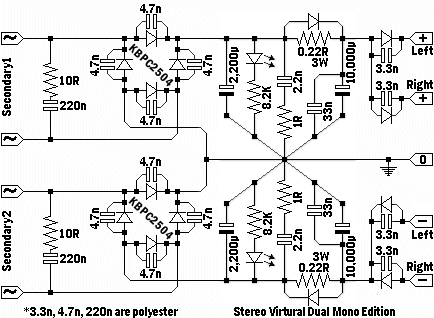
Here are my suggestions:
- GET RID OF THE DIODES (to the right of the bridge rectifer... you might need those)!!!
- Where there was a cap in parallel with the diode, get rid of that too
- Don't bother with the snubbers on the diode bridge. The single series resistor in between the two banks of caps attenuates any diode ringing.
- Increase the 0.22R resistor to 1 ohm and use a wire-wound 5W or larger ceramic/sandstone power resistor. When used in conjunction with the 10,000uF cap, this gives you the 15Hz corner frequency I mentioned.
- Eliminate the 2.2n+1R snubber
- Do you really need LEDs for your rails? A PS is not a christmas tree.. but do use a 1k ohm 3W resistor to bleed the caps at turn off (or omit, they will bleed themselves eventually).
NOTE:the star as you have drawn it is OK with the dual bridges off of dual secondaries as shown. If a center tapped transformer with a single diode bridge is used DO NOT use a single star as shown. Instead, the first pair of caps must be connected with the transformer secondary at a single point, then a WIRE must connect this point to the point in between the second pair of caps, and that is where the earth ground should be connected and all grounds should return. This will restrict the strong current pulses coming from the diode bridge to the first pair of caps. I'm not sure why the other espousers of this practice (AndrewT, Sreten, etc.) have not made this more clear. It is important to note that you absolutely can not pull that off if there is only a single pair of reservoir capacitors.
So, attached are the two topologies I am suggesting.
-Charlie
.
Attachments
<snipped>
Remember, this is just the power supply. There is a tenuous connection to what you would actually "hear" from the amplifier, so do not do listening tests to "proof" your tweaks!!!
<snipped>
-Charlie
.
Actually, almost always, the power supply capacitor current is exactly the signal that you hear. For very-convincing "proof", see the image from an LT-Spice simulation that I attached to post # 372 of this thread:
http://www.diyaudio.com/forums/power-supplies/216409-power-supply-resevoir-size-38.html#post3117390
Cheers,
Tom
Last edited:
- Status
- This old topic is closed. If you want to reopen this topic, contact a moderator using the "Report Post" button.
- Home
- Amplifiers
- Power Supplies
- Power Supply Resevoir Size
